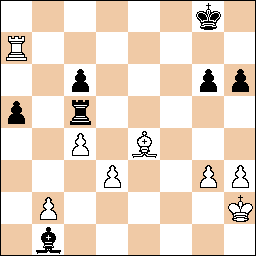Wednesday, May 03, 2006
Considerations

1.Nf3 Nc6 2.g3 e5 3.d3 d5 4.e4 d4 5.Bg2 Bg4 6.O-O Bd6 7.h3 Bh5 8.Kh2 Nf6 9.Nbd2 h6
10.Qe1 O-O 11.Nc4 Bc5 12.Nfxe5 Nxe5 13.Nxe5 Nd7 14.Nxd7 Qxd7 15.f4 Rfe8 16.Bd2 c6
17.Bb4 Bd6 18.e5 Bxb4 19.Qxb4 f6 20.Rae1 fxe5 21.fxe5 Bf7 22.Rf4 Rad8 23.Ree4 Qc7
24.Rxd4 Rxd4 25.Rxd4 Rxe5 26.Qd6 Qxd6 27.Rxd6 Bxa2 28.Rd8+ Kh7 29.Be4+ g6 30.Rd7+
Kg8 31.Rxb7 Bb1 32.c4 a5 33.Ra7 Rc5 34.Bxg6 Bc2 35.d4 Rxc4 36.Bf7+ Kf8 37.Bxc4
1-0
This is one of my best 2/12 blitz games this year. I had the White pieces and played a kind of Barcza opening which my opponent countered rather well. There are a couple of mistakes that I made in the middlegame under time pressure, but quite a few solid moves I am proud of, too. Anyway, I guess I am posting it in part as evidence that the circles have helped my game, in part to show an idea about thinking process.
Although I consider blitz to be just for fun, I do think it is instructive in revealing what you don't think of. By the time I reached the position (above), I felt that I was sitting pretty and there wasn't much potential for Black unless I screwed up. My attitude was to just play solid and grind it out, perhaps finding a conversion to a more simple endgame. I saw my Bishop taking the hanging g6 pawn and absolutely nothing else. In fact, I felt that the Bishop was cemented to the protection of the d3 pawn which really was keeping the c4 pawn safe. The discovered double attack on the Black Bishop and Rook with d4 just didn't occur to me. It was like the opposite of having a tactic pop-out. Perhaps having the Black Bishop behind the White pawns was so unusual I ignored the possibility, not remembering that tactics can happen in the endgame. I don't really like d4 better than Bxg6; d4 makes for many pawn losses/trades and opens lines to the White King. It certainly was worth considering, though.
Since chess is a mistake oriented activity, my opponent had the decency to also not fully consider his next move, and after 34.Bxg6 Bc2?? I first saw the f7 check, then the decoy/discovered attack idea, and finally played 35.d4. After Rxc4 Black had protected both of his pieces from the immediate threats, but this walked into the fork 36.Bf7+ Kf8 37.Bxc4.
TCT Results | Circle 1 | Circle 2 | Circle 3 | Circle 4 | Circle 5 | Circle 6 | Circle 7 |
| Step 1 | 97% | 99% | 99% | 100%r | |||
| Step 2 | 93% | 96% | 95% | 97% | 96% | 99% | 100% |
| Step 3 | 93% | 97% | 97% | 96% | 96% | 98% | 99% |
| Step 4 | 80% | 86% | 90% | 92% | 89% | ||
| Step 5 | 74% | 77% | 83% | 87% | 87%* |
I think this remark is very important. For me it was immedeately clear that d4 wins the game. It is probably the very reason why you didn't see it in the first place. I remember I had the same with a lot of exercises. But now I am used to the positions I start to appreciate them.
I suggest you take some time to look if both moves really are so equal as you think. Emotion plays an important role in recognizing patterns. d4 gives no uprise to your emotions I assume. It did to me.
I took some time, but now I see the relation to King of the Spill and King of the Hill. Oh well, english is not my native speech. . .
;-)
I generally lean towards keeping as many promotion threats going as possible, thinking he wants to trade pawns. Fritz sees the moves as fairly close with d4 slightly better. Bxg6 still seems easier to me, and d4 feels a tad nebulous.
who had a chapter on Anderssen and 4 games of his but only had brief snapshots of the immortal game. He felt the others he showed were more instructive. My favorite game of Anderssen is the Mayet/Anderssen game which I had memorized at one time. In fact I used that game as a template in a recent game at the chess club:: see blog.
Anderssen also had some beautiful King Gambit Games.You can learn alot through playing these KG games.
<< Home


